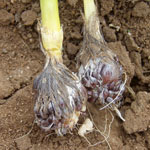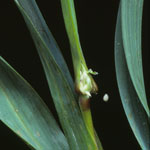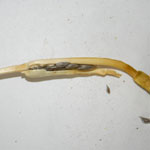Cape tulip (two-leaf)
Cape tulip (two-leaf) is a perennial herb growing to 60cm high.
Common name:
Cape tulip (two-leaf)
Scientific name:
- Moraea miniata Andrews
Other scientific name:
- Homeria miniata (Andr.) Sweet
Plant status
Catchment management authority boundaries
Regionally prohibited in the Mallee, Wimmera, Corangamite, Goulburn Broken, West Gippsland and East Gippsland catchments.
Regionally controlled in the Glenelg Hopkins, North Central, ,North East, Port Phillip and Westernport catchments.
Restricted in no areas in Victoria.
Plant biology

Appearance
Herbaceous plant — Forb (flowering herbaceous plant — not a grass)
Description
Cape tulip (two-leaf) is a perennial herb growing to 60cm high, with annual leaves and flowers growing from an underground corm surrounded by a black tunic.
Stems
Stems are stiff, erect and somewhat zigzagged.

Leaves
Each plant produces 2 or 3 leaves which are flat, 1 to 2cm wide and up to 80cm long.
Leaves are somewhat smaller than those of Cape tulip (one-leaf).
Flowers
Cape tulip (two-leaf) flowers are smaller and more numerous than those of Cape tulip (one-leaf). They grow 2 to 4cm in diameter with 6 pink to salmon coloured petals and yellow bases which are dotted with green.
Flowers are produced in clusters at the end of branch stems.

Seeds
Seeds of Cape tulip (two-leaf) are non-fleshy capsules, 9 to 16mm long, 1.5 to 2mm wide and are formed after flowering.
Growth and lifecycle
Method of reproduction and dispersal
Cape tulip (two-leaf) reproduces by 1 or 2 corms which are produced at the base of the plant. It also reproduces by cormils that are produced in the leaf axils and around the corms at the base of the plant.
Cultivation and movement of contaminated farm produce are the most common forms of dispersal for the Cape tulip (two-leaf) in an agricultural environment. Cape tulip corms can also be spread by floodwaters.
Flower emergence coincides with corm exhaustion in early spring (varies with subsoil moisture). Cormils begin to develop soon after flower emergence. Towards the end of spring the top growth dies down, cormils separate from the parent plant and the corms become dormant over summer.
Rate of growth and spread
Cape tulip (two-leaf) plants are 2 to 3 years old before they flower and produce viable corms and cormils. Corm germination and growth rate vary according to autumn rain events.
If sufficient rain is not received, corms will remain or become dormant until the next season. The rate of spread is dependant on the presence and persistence of suitable vectors.
Seedbank propagule persistence
Corms of the Cape tulip (two-leaf) may remain dormant in the soil for up to 8 years. It is estimated that in an established patch the weed can produce up to 200,000 cormils per square metre.
Preferred habitat
Cape tulip (two-leaf) has the ability to grow on a range of soils from light sands to heavier winter wet clays.
The weed prefers damp clay flats with ample light and little competition. It does not establish well in shaded sites.
This is generally a weed of grazing land and is found mostly in areas with annual rainfall of less than 600mm.
The weed will invade dry coastal heathland, heathy woodland, lowland grassland, grassy woodland, dry sclerophyll forest, woodland and freshwater wetland vegetation.
The plant can tolerate heavily waterlogged soil, mild frost and drought.
Growth calendar
The icons on the following table represent the times of year for flowering, seeding, germination, the dormancy period of Cape tulip (two-leaf) and also the optimum time for treatment.
| Jan | Feb | Mar | Apr | May | Jun | Jul | Aug | Sep | Oct | Nov | Dec | |
|---|---|---|---|---|---|---|---|---|---|---|---|---|
| Flowering | ||||||||||||
| Seeding | ||||||||||||
| Germination | ||||||||||||
| Dormancy | ||||||||||||
| Treatment |
Impact
Agricultural and economic impacts
All parts of the Cape tulip (two-leaf) plant are toxic to all types of grazing animals. The poison is a glycoside that causes:
- loss of appetite
- weakness
- depression
- blindness
- dysentery
- scouring
- paralysis and death.
Stock accustomed to grazing on infested pasture are usually not affected as they know not to eat the plants. This results in desirable pasture species being replaced by the Cape tulip (two-leaf) due to selective grazing which further decreases the lands stock carrying capacity.
Management
Prescribed measures for the control of noxious weeds:
- application of a registered herbicide.
Read about prescribed measures for the control of noxious weeds.
Other management techniques
Changes in land use practices and spread prevention may also support Cape tulip (two leaf) management after implementing the prescribed measures.